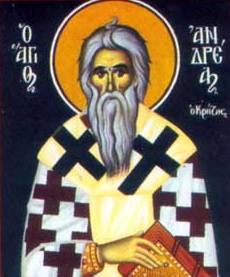The Great Canon of
Saint Andrew, is the longest canon in all of our
services, and is associated with Great Lent, since
the only times it is appointed to be read in church
are the first four nights of Great Lent (Clean
Monday through Clean Thursday, at Great Compline,
when it is serialized) and at Matins for Thursday of
the fifth week of Great Lent, when it is read in its
entirety.
The canon is a
dialog between Saint Andrew and his soul. The
ongoing theme is an urgent exhortation to change
one's life. Saint Andrew always mentions his own
sinfulness placed in juxtaposition to God's mercy,
and uses literally hundreds of references to good
and bad examples from the Old Testament and New
Testament to "convince himself" to repent.
"Where shall I
begin to lament the deeds of my wretched life? What
first-fruit shall I offer, O Christ, for my present
lamentation? But in Thy compassion grant me release
from my falls" (Hymn from the Canon).
A canon is an ancient
liturgical hymn, with a very strict format. It consists
of a variable number of parts, each called and "ode".
Most common canons have eight Odes, numbered from one to
nine, with Ode 2 being omitted. The most penitential
canons have all nine odes. Some canons have only three
Odes, such as many of the canons in the Triodion (which
means "Three Odes"). In any case, all Odes have the same
basic format. An "Irmos" begins each Ode. A variable
number of "troparia" follow, which are short hymns about
the subject of the canon. The Great Canon consists of
twelve Odes and has two hundred and fifty troparia
(hymns).
